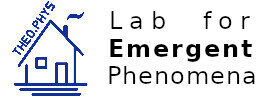PhD thesis – Ralf Kaminke
Ralf Kaminke
Fluid nanobubbles and adsorption at solid substrates [Full text via OPUS]
finished 2011-07
supervised by Klaus Mecke
Solid substrates can influence the phase behaviour of fluids in different ways.
Gas molecules can adsorb on a wall and build a liquid film. Since the surface of a substrate is normally corrugated, it provides discrete adsorption sites to the molecules. Thus closed to a solid substrate the entropy of a fluid is dominated by the occupation probability of this adsorption sites. So this thesis proposes a density functional theory which captures accurately the monolayer adsorption properties but covers also the growth of mesoscopic films and capillary condensation at hydrophilic conditions. This is applicable to calculate the dependence of wetting properties, pull-off forces and adhesion on temperature, humidity and substrate strength, in particular at the crossover from single particle to capillary condensed bridges. This becomes important for the description several biological systems. For example the gluing of a gecko an a wall is caused by adhesion forces between the wall and the gecko’s foot, enforced by the sophisticated hierarchical structure of this foot.
On the other hand a substrate can also make the stabilisation of gas nanobubbles in a liquid solution possible. Due to a large Laplace pressure such bubbles can not exist in a bulk liquid. But on a liquid solid surface they can form a spherical cap gas nanobubble. Making a density functional approach delivers a metastable or stable minimum of the grand canonical potential, depending on the size of the cap, the temperature and the substrate properties. So experimental observations on the existence of nanobubbles can be confirmed. Further an effective Laplace pressure, which captures the substrate properties, will be introduced. It solves the discrepancy between the pressure measured in nanobubbles and a higher pressure expected due to a high Laplace pressure arising from the small radius of such bubbles.
